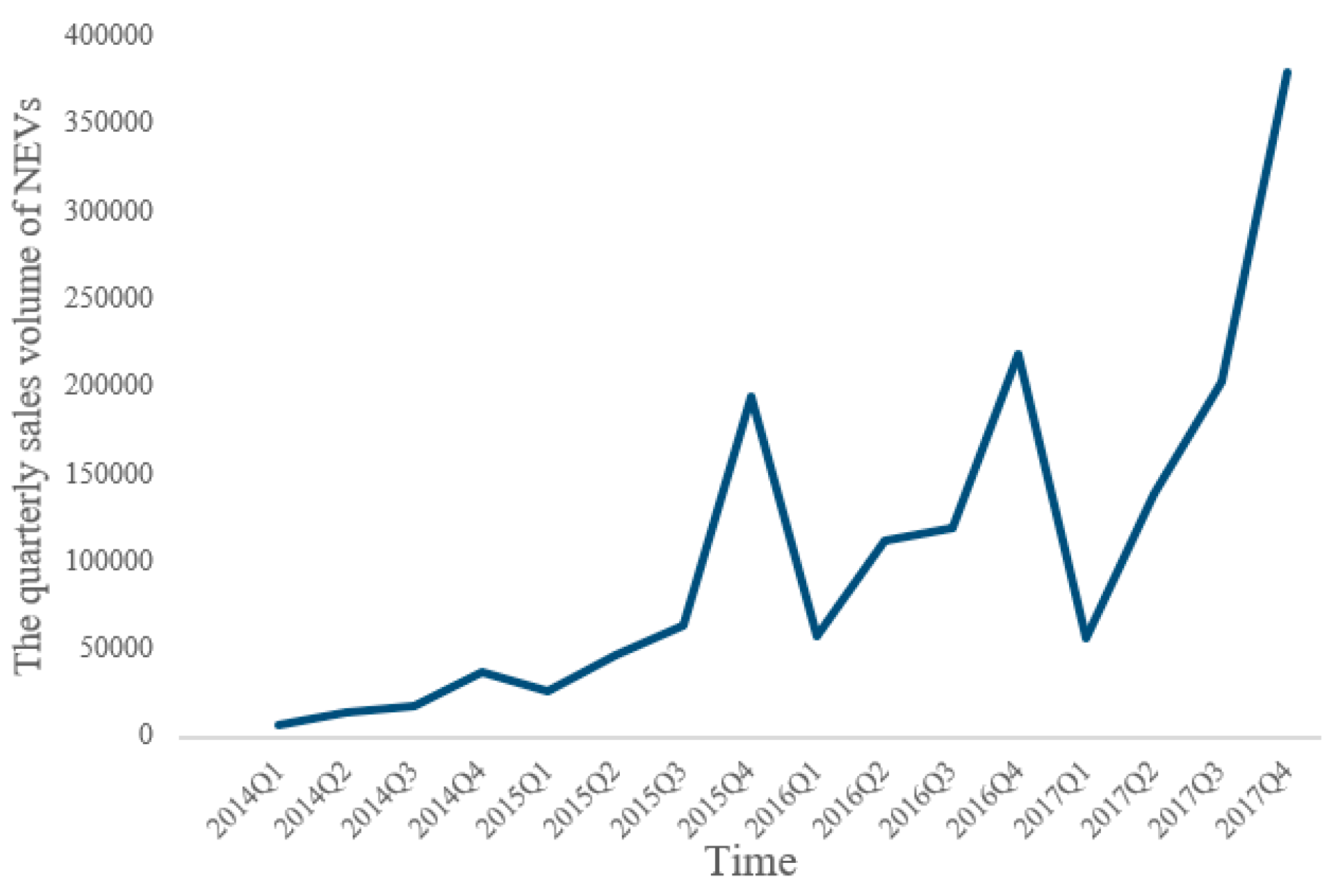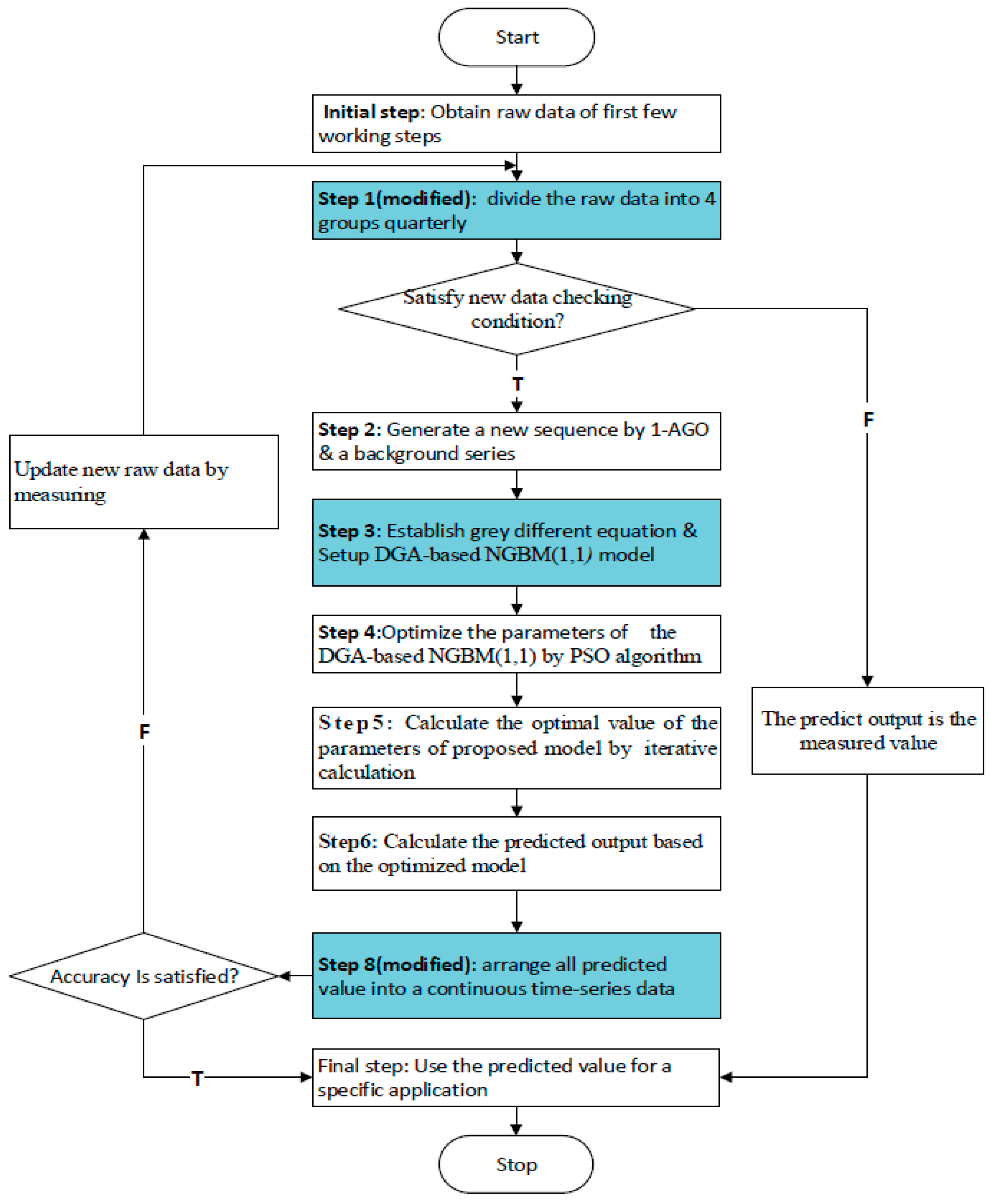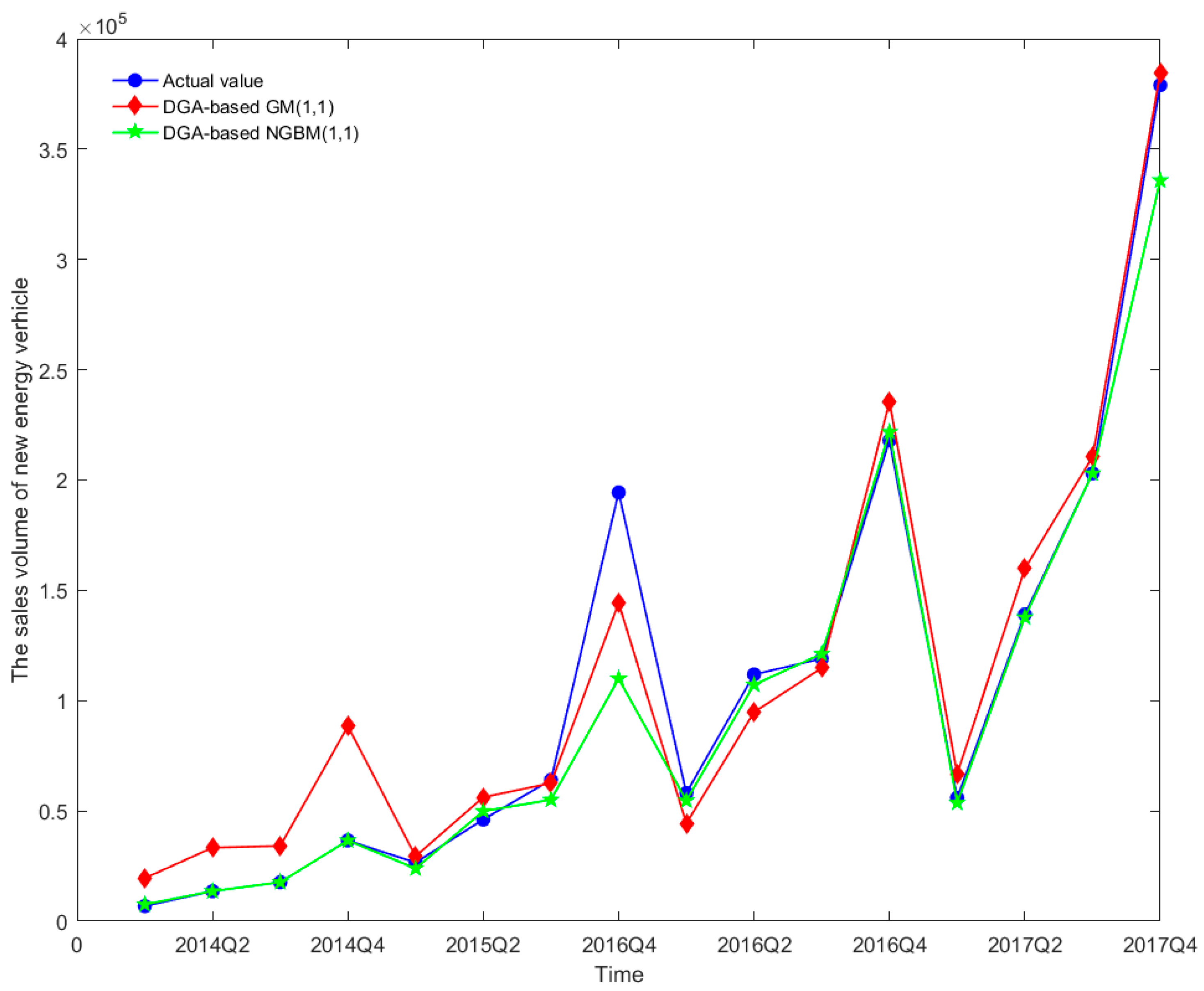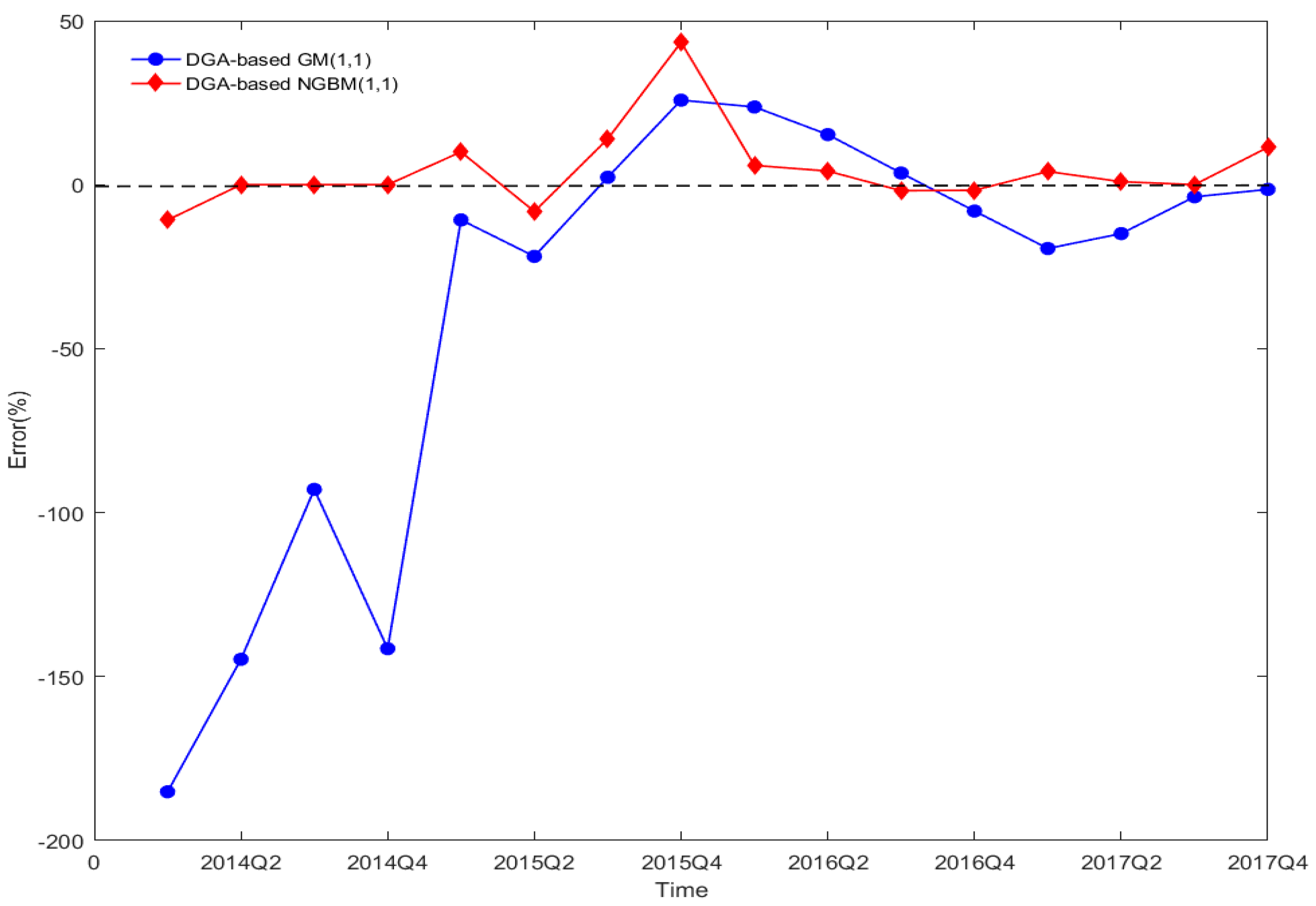Forecasting Quarterly Sales Volume of the New Energy Vehicles Industry in China Using a Data Grouping Approach-Based Nonlinear Grey Bernoulli Model
Abstract
:1. Introduction
1.1. Background and Motivation
1.2. Literature Review of the NEV Market
1.3. The Development of Grey Theory Model
1.4. Contribution and Organization
- (1)
- This paper proposed a data grouping approach-based nonlinear grey Bernoulli model (DGA-based NGBM (1,1)) which can effectively predict the quarterly fluctuations of quarterly sales of the new energy vehicle industry in China.
- (2)
- The parameters of the DGA-based NGBM (1,1) model are optimized by PSO algorithm to improve the prediction accuracy of the model.
2. Methodology
2.1. Data Grouping Approach-Based Nonlinear Grey Bernoulli Model
2.2. Parameters Optimization in the DGA-Based NGBM (1,1)
2.3. Model Evaluation Criteria
3. Empirical Analysis and Discussion
3.1. The Construction of the Two Models
3.1.1. DGA-Based GM (1,1)
3.1.2. DGA-Based NGBM (1,1)
3.2. The Comparison between DGA-Based GM (1,1) and DGA-Based NGBM (1,1)
3.3. Out-of-Sample Forecasting and Discussion
4. Conclusions
Author Contributions
Funding
Acknowledgments
Conflicts of Interest
References
- Yao, M.; Liu, H.; Xuan, F. The development of low-carbon vehicles in China. Energy Policy 2011, 39, 5457–5464. [Google Scholar] [CrossRef]
- China Association of Automobile Manufacturers. Available online: http://www.caam.org.cn/qiyexinwen /20171011/1005212242.html (accessed on 8 June 2018).
- Fang, X.F. The Development Planning of Energy Saving and New Energy Automobile Industry. Chin. Automob. Ind. 2012, 7, 10–14. [Google Scholar]
- Deng, J.L. Introduction of grey system. J. Grey Syst. 1989, 1, 1–24. [Google Scholar]
- Zhang, L.; Liu, Y. Analysis of New Energy Vehicles Industry Policy in China’s Cities from the Perspective of Policy instruments. Energy Procedia 2016, 104, 437–442. [Google Scholar] [CrossRef]
- Zhang, X.; Bai, X. Incentive policies from 2006 to 2016 and new energy vehicle adoption in 2010–2020 in China. Renew. Sustain. Energy Rev. 2017, 70, 24–43. [Google Scholar] [CrossRef]
- Lin, B.; Tan, R. Estimation of the environmental values of electric vehicles in Chinese cities. Energy Policy 2017, 104, 221–229. [Google Scholar] [CrossRef]
- Peng, Z. Price-dependent Decision of New Energy Vehicles Considering Subsidies and Backorders. Energy Procedia 2017, 105, 2065–2070. [Google Scholar] [CrossRef]
- Wang, Z.; Zhao, C.; Yin, J.; Zhang, B. Purchasing intentions of Chinese citizens on new energy vehicles: How should one respond to current preferential policy? J. Clean. Prod. 2017, 161, 1000–1010. [Google Scholar] [CrossRef]
- Lin, B.; Tan, R. Are people willing to pay more for new energy bus fares? Energy 2017, 130, 365–372. [Google Scholar] [CrossRef]
- Zeng, M.; Zeng, F.X.; Zhu, X.L.; Xue, S. Forecast of electric vehicles in China based on Bass model. Electr. Power 2013, 46, 36–39. [Google Scholar]
- Zeng, B.; Luo, C.; Liu, S.F.; Chuan, L. A novel multi-variable grey forecasting model and its application in forecasting the amount of motor vehicles in Beijing. Comput. Ind. Eng. 2016, 101, 479–489. [Google Scholar] [CrossRef]
- Xu, S.; Zhao, X. Predication of patent application quantity in NEVs industry in in the 13th Five-Year-Plan period using an equal dimension gray recurrence model. Marketpl. Mod. 2017, 12, 16–17. [Google Scholar]
- Deng, J.L. Control problems of grey system. Syst. Control Lett. 1982, 1, 288–294. [Google Scholar]
- Jiang, F.; Yang, X.; Li, S.Y. Comparison of Forecasting India’s Energy Demand Using an MGM, ARIMA Model, MGM-ARIMA Model, and BP Neural Network Model. Sustainability 2018, 10, 2225. [Google Scholar] [CrossRef]
- Zeng, B.; Zhou, M.; Zhang, J. Forecasting the Energy Consumption of China’s Manufacturing Using a Homologous Grey Prediction Model. Sustainability 2017, 9, 1975. [Google Scholar] [CrossRef]
- Xie, N.M.; Liu, S.F. Discrete grey forecasting model and its optimization. Appl. Math. Model. 2009, 33, 1173–1186. [Google Scholar] [CrossRef]
- Liu, S.F.; Yang, Y.J.; Xie, N.M.; Forrest, J. New progress of Grey System Theory in the new millennium. Grey Syst. Theory Appl. 2016, 6, 2–31. [Google Scholar] [CrossRef]
- Chen, C.I.; Chen, H.L.; Chen, S.P. Forecasting of foreign exchange rates of Taiwan’s major trading partners by novel nonlinear Grey Bernoulli model NGBM (1,1). Commun. Nonlinear Sci. Numer. Simul. 2008, 13, 1194–1204. [Google Scholar] [CrossRef]
- Deng, J.L. Grey Control System; Huazhong University of Science and Technology Press: Wuhan, China, 1993. [Google Scholar]
- Chen, C.I. Application of the novel nonlinear grey Bernoulli model for forecasting unemployment rate. Chaos Solitons Fractals 2008, 37, 278–287. [Google Scholar] [CrossRef]
- Tsai, S.B.; Xue, Y.; Zhang, J.Y.; Chen, Q.; Liu, Y.B.; Zhou, J.; Dong, W.W. Models for forecasting growth trends in renewable energy. Renew. Sustain. Energy Rev. 2016, 77, 1169–1178. [Google Scholar] [CrossRef]
- Chen, C.I.; Hsin, P.H.; Wu, C.S. Forecasting Taiwan’s major stock indices by the Nash nonlinear grey Bernoulli model. Expert Syst. Appl. 2010, 37, 7557–7562. [Google Scholar] [CrossRef]
- Wang, Z.X.; Zhu, H.T.; Ye, D.J. Increasing Prediction Precision of NGBM (1,1) Based on 1-WAGO and 1-WIAGO Techniques. J. Grey Syst. 2016, 28, 107–120. [Google Scholar]
- Wang, Z.X. A Predictive Analysis of Clean Energy Consumption, Economic Growth and Environmental Regulation in China Using an Optimized Grey Dynamic Model. Comput. Econ. 2015, 46, 437–453. [Google Scholar] [CrossRef]
- Pao, H.T.; Fu, H.C.; Tseng, C.L. Forecasting of CO2, emissions, energy consumption and economic growth in China using an improved grey model. Energy 2012, 40, 400–409. [Google Scholar] [CrossRef]
- Shaikh, F.; Ji, Q.; Shaikh, P.H.; Uqaili, M.A. Forecasting China’s natural gas demand based on optimized nonlinear grey models. Energy 2017, 140, 941–951. [Google Scholar] [CrossRef]
- Hsin, P.H.; Chen, C.I. Application of game theory on parameter optimization of the novel two-stage Nash nonlinear grey Bernoulli model. Commun. Nonlinear Sci. Numer. Simul. 2015, 27, 168–174. [Google Scholar] [CrossRef]
- Wang, Z.X.; Ye, D.J. Forecasting Chinese carbon emissions from fossil energy consumption using non-linear grey multivariable models. J. Clean. Prod. 2017, 142, 600–612. [Google Scholar] [CrossRef]
- Wang, Z.X.; Ye, D.J. A weighted non-linear grey Bernoulli model for forecasting non-linear economic time series with small data sets. Econ. Comput. Econ. Cybern. Stud. Res. 2017, 51, 169–186. [Google Scholar]
- Zhou, J.Z.; Fang, R.; Li, Y.; Zhang, Y.C.; Peng, B. Parameter optimization of nonlinear grey Bernoulli model using particle swarm optimization. Appl. Math. Comput. 2009, 207, 292–299. [Google Scholar] [CrossRef]
- An, Y.; Zou, Z.H.; Zhao, Y.F. Forecasting of dissolved oxygen in the Guanting reservoir using an optimized NGBM (1,1) model. J. Environ. Sci. 2015, 29, 158–164. [Google Scholar] [CrossRef] [PubMed]
- Zhang, L.P.; Zheng, Y.L.; Wang, K.; Zhang, X.L.; Zheng, Y.J. An optimized Nash nonlinear grey Bernoulli model based on particle swarm optimization and its application in prediction for the incidence of Hepatitis B in Xinjiang, China. Comput. Biol. Med. 2014, 49, 67–73. [Google Scholar] [CrossRef] [PubMed]
- Hsu, L.C. A genetic algorithm based nonlinear grey Bernoulli model for output forecasting in integrated circuit industry. Expert Syst. Appl. 2010, 37, 4318–4323. [Google Scholar] [CrossRef]
- Liu, S.F.; Deng, J.L. Applicative scope of the GM (1,1) model. Syst. Eng. Theory Pract. 2000, 20, 121–124. [Google Scholar]
- Wang, Z.X.; Li, Q.; Pei, L.L. Grey forecasting method of quarterly hydropower production in China based on a data grouping approach. Appl. Math. Model. 2017, 51, 302–316. [Google Scholar] [CrossRef]
- Ma, X.; Hu, Y.S.; Liu, Z.B. A novel kernel regularized nonhomogeneous grey model and its applications. Commun. Nonlinear Sci. Numer. Simul. 2017, 48, 51–62. [Google Scholar] [CrossRef]
- Ma, X.; Liu, Z.B. The kernel-based nonlinear multivariate grey model. Appl. Math. Model. 2017, 56, 217–238. [Google Scholar] [CrossRef]
- Eberhart, R.; Kennedy, J. A new optimizer using particle swarm theory. In Proceedings of the International Symposium on MICRO Machine and Human Science, Nagoya, Japan, 4–6 October 2002; IEEE: Piscataway, NJ, USA, 2002; pp. 39–43. [Google Scholar]
- Kennedy, J. Eberhart Particle swarm optimization. IEEE International Conference on Neural Networks. Proc. IEEE 1995, 4, 1942–1948. [Google Scholar]
- Lewis, C. Industrial and Business Forecasting Methods; Butterworth Scientific: London, UK, 1982. [Google Scholar]
- Shi, Y.; Eberhart, R. A modified particle swarm optimizer. Inst. Electr. Electron. 1998, 9, 69–73. [Google Scholar]
- Lu, A.L.; Zhang, J.; Zhao, S.M. Accuracy and error test of grey model. J. Huazhong Univ. Sci. Technol. 1998, 26, 41–42. [Google Scholar]
- Ye, C.; Wu, C.H.; Zhang, J.Y. Comparison about how to get rid of abnormal data in metrology and measurement. Metrol. Test. Technol. 2007, 34, 26–27. [Google Scholar]
- Xiao, L.; Shao, W.; Wang, C.; Zhang, K.; Lu, H.Y. Research and application of a hybrid model based on multi-objective optimization for electrical load forecasting. Appl. Energy 2016, 180, 213–233. [Google Scholar] [CrossRef]
- China Electric Vehicle Charging Infrastructure Promotion. Available online: Alliance. http://www.evcipa.org.cn/ (accessed on 23 January 2019).





| MAPE (%) | Forecasting Ability | MAPE (%) | Forecasting Ability |
|---|---|---|---|
| <10 | High forecasting | 20–50 | Reasonable forecasting |
| 10–20 | Good Forecasting | >50 | Weak forecasting |
| Coefficients | Q1 | Q2 | Q3 | Q4 |
|---|---|---|---|---|
| 0.5497 | 0.5557 | 0.6041 | 0.5499 | |
| 2.4454 | 1.3004 | 1.0272 | 0.9873 |
| Time | Actual Value | DGA-Based GM (1,1) | DGA-Based NGBM (1,1) | ||
|---|---|---|---|---|---|
| Model Value | Error (%) | Model Value | Error (%) | ||
| 2014Q1 | 6853 | 19,539.93 | −185.13 | 7592.58 | −10.79 |
| 2014Q2 | 13,624 | 33,341.34 | −144.73 | 13,624.00 | 0.00 |
| 2014Q3 | 17,686 | 34,120.17 | −92.92 | 17,686.00 | 0.00 |
| 2014Q4 | 36,600 | 88,382.89 | −141.48 | 36,600.00 | 0.00 |
| 2015Q1 | 26,581 | 29,437.51 | −10.75 | 23,925.46 | 9.99 |
| 2015Q2 | 46,130 | 56,216.45 | −21.87 | 49,910.77 | −8.20 |
| 2015Q3 | 64,022 | 62,579.31 | 2.25 | 55,086.76 | 13.96 |
| 2015Q4 | 194,359 | 144,276.68 | 25.77 | 109,959.62 | 43.42 |
| 2016Q1 | 58,125 | 44,348.52 | 23.70 | 54,709.70 | 5.88 |
| 2016Q2 | 111,875 | 94,785.91 | 15.28 | 107,230.30 | 4.15 |
| 2016Q3 | 119,000 | 114,775.81 | 3.55 | 121,187.50 | −1.84 |
| 2016Q4 | 218,000 | 235,517.98 | −8.04 | 221,736.76 | −1.71 |
| 2017Q1 | 55,929 | 66,812.42 | −19.46 | 53,683.73 | 4.01 |
| 2017Q2 | 139,071 | 159,817.42 | −14.92 | 137,816.66 | 0.90 |
| 2017Q3 | 203,000 | 210,508.66 | −3.70 | 203,000.00 | 0.00 |
| 2017Q4 | 379,000 | 384,460.74 | −1.44 | 335,854.01 | 11.38 |
| RMSE | MAE | MAPE (%) | |
|---|---|---|---|
| DGA-based GM (1,1) | 21741.54 | 16393.52 | 44.69 |
| DGA-based NGBM (1,1) | 23907.59 | 10071.27 | 7.26 |
| Coefficients | Q1 | Q2 | Q3 | Q4 |
|---|---|---|---|---|
| 0.4768 | 0.6339 | 0.4966 | 0.4897 | |
| 1.8957 | 1.6447 | 0.3946 | −0.0020 |
| Time | Actual Value | Forecasted Value | Error (%) |
|---|---|---|---|
| 2018Q1 | 143,000 | 29,978.98 | −79.04 |
| 2018Q2 | 269,000 | 81,594.23 | −69.67 |
| 2018Q3 | 309,484 | 341,844.6 | 10.46 |
| 2018Q4 | 534,516 | 617,674.4 | 15.56 |
| Time | Forecasted Value | Growth Rate | Time | Forecasted Value | Growth Rate |
|---|---|---|---|---|---|
| 2019Q1 | 259,813.934 | 81.69% | 2020Q1 | 473,419.512 | 82.21% |
| 2019Q2 | 433,198.622 | 61.04% | 2020Q2 | 683,816.165 | 57.85% |
| 2019Q3 | 470,656.118 | 52.08% | 2020Q3 | 702,788.732 | 49.32% |
| 2019Q4 | 816,162.574 | 52.69% | 2020Q4 | 1,255,038.52 | 53.77% |
| All | 1,979,831.25 | 57.63% | 3,115,062.93 | 57.34% |
© 2019 by the authors. Licensee MDPI, Basel, Switzerland. This article is an open access article distributed under the terms and conditions of the Creative Commons Attribution (CC BY) license (http://creativecommons.org/licenses/by/4.0/).
Share and Cite
Pei, L.-L.; Li, Q. Forecasting Quarterly Sales Volume of the New Energy Vehicles Industry in China Using a Data Grouping Approach-Based Nonlinear Grey Bernoulli Model. Sustainability 2019, 11, 1247. https://doi.org/10.3390/su11051247
Pei L-L, Li Q. Forecasting Quarterly Sales Volume of the New Energy Vehicles Industry in China Using a Data Grouping Approach-Based Nonlinear Grey Bernoulli Model. Sustainability. 2019; 11(5):1247. https://doi.org/10.3390/su11051247
Chicago/Turabian StylePei, Ling-Ling, and Qin Li. 2019. "Forecasting Quarterly Sales Volume of the New Energy Vehicles Industry in China Using a Data Grouping Approach-Based Nonlinear Grey Bernoulli Model" Sustainability 11, no. 5: 1247. https://doi.org/10.3390/su11051247
APA StylePei, L.-L., & Li, Q. (2019). Forecasting Quarterly Sales Volume of the New Energy Vehicles Industry in China Using a Data Grouping Approach-Based Nonlinear Grey Bernoulli Model. Sustainability, 11(5), 1247. https://doi.org/10.3390/su11051247




